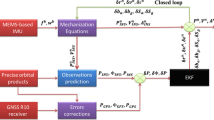Abstract
The accuracy of global positioning system (GPS) is not so high because of errors. Therefore, the differential GPS (DGPS) which is based on the successive transmission of correction factors is often used. The main parts of the system are a reference station and a user one. In this paper, reference position components error (RPCE) factors are used for implementing the system. The theory of increasing the accuracy of this system is based on the fact that if the satellites used in both stations are the same, the sources and the values of position error would almost be close to each other in both stations as well. In order to compensate the processing delays of the reference station, the RPCE factors were predicted by using the hybrid auto regressive moving average neural network algorithm. Simulation results showed that the root mean square (RMS) error of the prediction algorithm is 0.22 m. Moreover, practical tests by hardware board revealed the RMS error of positioning system is 0.45 m.











Similar content being viewed by others
References
Berber, M., Ustun, A., & Yetkin, M. (2012). Comparison of accuracy of GPS techniques. Journal of Measurement, 45, 1742–1746.
McDonald, K. D. (2002). The modernization of GPS: Plans, new capabilities, and the future relationship to Galileo. Journal of Global Positioning System, 1, 1–17.
Mosavi, M. R., Mohammadi, K., & Refan, M. H. (2004). A new approach for improving of GPS positioning accuracy by using an adaptive neurofuzzy system, before and after S/A is turned off. International Journal of Engineering Science, Iran University of Science and Technology, 15, 95–108.
Jwo, D. J., & Chin, K. P. (2002). Applying back-propagation neural networks to GDOP approximation. The Journal of Navigation, 55, 97–108.
Mosavi, M. R. (2010). An effective method for GPS GDOP clustering using ant colony optimization algorithm. Asian Journal of Geoinformatics, 10, 91–97.
Mohasseb, M., Rabbany, A., Alim, O., & Rashad, R. (2007). DGPS correction prediction using artificial neural networks. The Journal of Navigation, 60, 291–301.
Zhang, J., Zhang, K., Grenfell, R., & Deakin, R. (2006). GPS satellite velocity and acceleration determination using the broadcast ephemeris. Journal of Navigation, 59, 293–305.
Yeh, T. K., Wang, C. S., Lee, C. W., & Liou, Y. A. (2006). Construction and uncertainty evaluation of a calibration system for GPS receivers. Metrologia, 43, 451–460.
Mosavi, M. R. (2006). Comparing DGPS corrections prediction using neural network, fuzzy neural network, and Kalman filter. Journal of GPS Solutions, 10, 97–107.
Kawamura, K., & Tanaka, T. (2006). Study on the improvement of measurement accuracy in GPS. In SICE-ICASE international joint conference (pp. 1372–1375).
Mosavi, M. R. (2004). A wavelet based neural network for DGPS corrections prediction. WSEAS Transactions on Systems, Greece, 3, 3070–3075.
Mosavi, M. R. (2010). Estimation of pseudo-range DGPS corrections using neural networks trained by evolutionary algorithms. Journal of Review of Electrical Engineering, 5, 2715–2720.
Jwo, D., Lee, T., & Tseng, Y. W. (2004). ARMA neural networks for predicting DGPS pseudo range correction. The Journal of Navigation, 57, 275–280.
Geng, Y. (2007). Online DGPS correction prediction using recurrent neural networks with unscented Kalman filter. In International global navigation satellite systems society IGNSS symposium. The University of New South Wales, Sydney.
Park, B., Kim, J., & Kee, C. (2006). RRC unnecessary for DGPS messages. IEEE Transactions on Aerospace and Electronic Systems, 42, 1149–1160.
Indriyatmoko, A., Kang, T. Y. J., Lee, G. I., Jee, Y. B., & Kim, J. (2008). Artificial neural network for predicting DGPS carrier phase and pseudo-range correction. Journal of GPS Solutions, 12, 237–247.
RTCM Recommended Standards For Differential GNSS (Global navigation satellite systems) Service version 2.2. Developed by RTCM special committee no. 104. January 15, 1998.
Yinglei, X., Qunzhan, L., Shaofeng, X., & Liyan, Z. (2009). Study on algorithm and communication protocol of differential GPS positioning based on pseudorange. In International forum on information technology and applications.
Chiang, C. T., & Hsu, J. S. (2009). Improvement in DGPS accuracy using recurrent S_CMAC_GBF. World Academy of Science, Engineering and Technology, 55, 422–427.
Geng, Y. (2007). Online DGPS correction prediction using recurrent neural networks with unscented Kalman filter. In International global navigation satellite systems society IGNSS symposium. The University of New South Wales, Sydney.
Mosavi, M. R., & Nabavi, H. (2011). Improving DGPS accuracy using neural network modeling. Australian Journal of Basic and Applied Sciences, 5, 848–856.
Refan, M. H., & Dameshghi, A. (2013). RTDGPS implementation by online prediction of GPS position components error using GA-ANN model. Journal of Electrical and Computer Engineering Innovations, 1, 43–50.
Refan, M. H., & Dameshghi, A. (2012). Comparing error predictions of GPS position components using, ARMANN, RNN, and ENN in order to use in DGPS. In 20th telecommunications forum TELFOR, Belgrad (SERBIA).
Ranjbar, M., & Mosavi, M. R. (2012). Simulated annealing clustering for optimum GPS satellite selection. International Journal of Computer Science Issues, 9, 100–104.
Zhang, G. P. (2003). Time series forecasting using a hybrid ARIMA and neural network model. Journal of Neuro Computing, 50, 159–175.
Zhang, S., & Liu, R. (2003). A rapid algorithm for online and real-time ARMA modeling. In International conference on signal processing (ICSP).
Wang, C. C. (2011). A comparison study between fuzzy time series model and ARIMA model for forecasting Taiwan export. Expert Systems with Applications, 38, 9296–9304.
User Guide. U-center, GPS evaluation software. [Online]. Available: http://www.u-blox.com/en/evaluation-tools-a-software/u-center/u-center.html.
U-blox 6 Receiver Description Including Protocol Specification, [Online]. Available: http://www.u-blox.com/en/gps-modules.html.
ZigBee Serial Adapter ProBee-ZS10 User Guide Sena Technologie. [Online]. Available: http://www.sena.com/products/industrial_zigbee/zs10.php.
SAM7S Series Datasheet. [Online]. Available: www.atmel.com.
Author information
Authors and Affiliations
Corresponding author
Rights and permissions
About this article
Cite this article
Refan, M.H., Dameshghi, A. & kamarzarrin, M. Implementation of DGPS Reference and User Stations Based on RPCE Factors. Wireless Pers Commun 90, 1597–1617 (2016). https://doi.org/10.1007/s11277-016-3413-7
Published:
Issue Date:
DOI: https://doi.org/10.1007/s11277-016-3413-7




